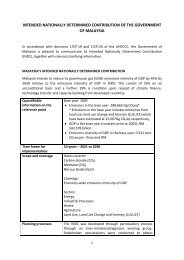RP-01638
RP-01638
RP-01638
Create successful ePaper yourself
Turn your PDF publications into a flip-book with our unique Google optimized e-Paper software.
Philippines<br />
Antonio Bravo<br />
This report outlines the field testing of the<br />
Waterloo handpump in the Philippines from<br />
January 1980 to May 1982.<br />
The project sought to attain the following<br />
four objectives: (1) to field test the Waterloo<br />
handpump in the rural areas; (2) to evaluate<br />
the technical viability of the handpump by<br />
assessing its operational performance in terms<br />
of volumetric efficiency, mechanical efficiency,<br />
and ease of usage; (3) to determine problems<br />
related to the operation and use of the pump<br />
and provide solutions for the improvement<br />
in design and reliability of the pump; and<br />
(4) to assess prospects for eventual adoption<br />
of the Waterloo pump in the national program<br />
of handpump development.<br />
In accordance with specifications provided<br />
by the International Development Research<br />
Centre (IDRC), prototypes of the Waterloo<br />
handpump were fabricated and installed in<br />
specific areas in the Philippines. Thirty<br />
handpumps were installed in Laguna, Cavite,<br />
Pangasinan, and Nueva Ecija. The sites<br />
chosen were typical rural communities where<br />
water supply is a problem and where a<br />
minimum of 10-20 users reside.<br />
Periodic visits were made to the pump sites<br />
to monitor the performance of the pumps.<br />
Employing a monitoring format agreed upon<br />
by the representatives of the countries<br />
involved in the network project during a<br />
meeting held in Malaysia in the latter part<br />
of 1980, various parameters were observed<br />
and measured.<br />
Pump Design and Construction<br />
Below-ground components<br />
The project team used a 3-inch (7.5-cm)<br />
diameter polyvinyl chloride (PVC) pipe for<br />
the well casing, which also functions as the<br />
pump cylinder. Pipes, 10 feet (3 m) long,<br />
were joined using PVC solvent cernent and<br />
PVC couplings. The nominal pipe dimensions<br />
were 88.7 mm OD x 79.26 mm ID. The piston<br />
was machined from solid PVC stock. Two<br />
polyethylene rings each with a diameter of<br />
3 inches (76.5 mm) and a thickness of 5116<br />
inch (7.93 mm) were used. The first (upper)<br />
piston ring was 5/9 inch (14.2 mm) wide<br />
whereas the lower one was 0.25 inch<br />
(6.35 mm). Eight 0.25-inch (6.35-mm) holes<br />
were drilled in the piston (Fig. lA).<br />
The project team decided to use an irrecoverable<br />
foot valve. Both piston and foot<br />
valve were basically similar except that the<br />
foot valve had larger holes than the piston<br />
(0.5 inch; 12.7 mm) (Fig. 1B). The foot valve<br />
was redesigned therefore, and, instead of two<br />
polyethylene rings, a rubber gasket (ID 2.34<br />
inch and OD 3.5 inch; 59.5 and 88.9 mm)<br />
was used.<br />
The foot valve was further modified by<br />
incorporating a brass spring. The valve seat<br />
was also chamfered to prevent sand particles<br />
from wedging between the flapper valve and<br />
the base (Fig. 2).<br />
PVC pipes (OD 1.06 inch and ID 0.81 inch;<br />
26.8 and 20.5 mm) were used as piston rods.<br />
These were 10 feet (3 m) long and were<br />
joined using PVC couplings and PVC solvent<br />
cement. A PVC screen filter (about 10 feet,<br />
3 m, long) was incorporated in several pumps<br />
during installation. This PVC screen and<br />
sandtrap was improvised by cutting slots<br />
diagonally along a section of PVC pipe with<br />
a hacksaw. These slots were 0.25 inch (6 mm)<br />
apart and 1 inch (2.5 cm) long across the<br />
pipe. The end of the filter was cut and bent to<br />
give it a conical shape.<br />
Above-ground components<br />
The above-ground components consisted<br />
of a wooden handle assembly, metal yoke, a<br />
concrete pedestal, and a concrete platform<br />
reinforced by 0.5-inch (1.25-cm) steel reinforcement<br />
bars. The wooden handle was<br />
originally connected to the piston rod by a<br />
metal flange. This flange was connected by<br />
a bolt to a steel block into which a brass<br />
fitting connected to the piston rod was<br />
screwed. A problem in the design of this<br />
linkage caused the piston rod to buckle during<br />
operation. This was remedied by using a solid<br />
iron rod for the upper portion of the piston<br />
rod (Fig. 3). The pedestal for the pump was<br />
33



